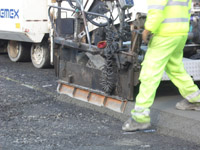Roads
Concrete, as well as cement and other Hydraulically Bound Mixtures (HBM) in road construction can provide whole life cost benefits. More recently, use of concrete, including cement bound granular mixtures (CBGM) are reported as contributing to initial cost competitive solutions, and are increasingly specified. A recent study by Britpave confirms the cost advantages of cementitious solutions. Download. In addition research indicates reduced operational carbon emissions from cementitious solutions.
For residential and industrial roads concrete block paving is also a viable option. Read more here or visit Interpave at www.paving.org.uk.
The main specification for road pavements is the Highways Agency Design Manual for Roads and Bridges (DMRB) and Specification for Highway Works (SHW). The current DMRB Pavement Design method is set out in HD26/06 where it is assumed that the pavement is either flexible or rigid.
For flexible areas, the upper layers of pavement are bound in bitumen and the lower layers are either bound in bitumen or with a hydraulic binder. Where the lower layers are hydraulically bound materials the pavement may be designated ‘flexible composite’ or colloquially just as ‘composite’.
Rigid pavement constructions are:
- Continuously Reinforced Concrete Pavement (CRCP), normally with an asphalt overlay of minimum thickness 30mm.
- Continuously Reinforced Concrete Base (CRCB) with an asphalt overlay of 100mm.
- Unreinforced Jointed Concrete (URC).
- Jointed Reinforced Concrete (JRC).
- Other forms of rigid construction are permitted with approval of the Overseeing Organisation.
Pavement design deals with elements as follows:
Pavement - surface course and binder/base – these are always bound layers
Foundation - can be constructed from bound or unbound materials
Formation or Construction Platform - can be existing, unbound, or lightly bound materials.

The overall designs depend on the nature of the formation, the materials used and the traffic intensity and intended design life of the road.
When using the term ‘bound’ layers – the aggregate is coated with a binder – this can be bitumen and bituminous emulsions, or hydraulic (cement, hydrated lime, ground granulated blast furnace slag, fly ash) or a combination of both (e.g. Quick Visco-Elastic combine foamed bitumen with cement).
Surface course
Concrete offers a durable and chemical resistant wearing surface. It is for these reasons that some off-highway applications for infrastructure and local authority clients have used roller compacted concrete pavements as a wearing surface. Case study example: Druids Lane Bus Terminal Birmingham. Download.
For surfaces (off-highway) subjected to heavily loaded vehicles particularly with turning (e.g. Inter modal depots: road/rail, ports) or chemical attack (e.g. fuel spills, oil drips from vehicle parking such as bus stations, waste/recycling transfer depots) concrete is the preferred solution.
Whilst trials of Exposed Aggregate Concrete Surface EACS, previously called whisper concrete, delivered 17 years of good acoustic performance (with good maintenance free service which was longer than the alternative materials) concrete is still perceived to be a noisy wearing surface even if it has equivalent characteristics to hot rolled asphalt. The concrete industry is working towards achieving concrete surface courses with noise attenuation that meets current noise criteria.
Foundations
Hydraulic bound materials (HBMs) such as CBGM can be utilised in the foundation or in the upper pavement as base, as well as other applications. For more information, download a copy of Hydraulically-bound Mixtures for Pavements from the Pubilcations Library.